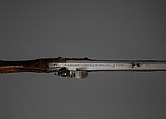On loan to The Met The Met accepts temporary loans of art both for short-term exhibitions and for long-term display in its galleries.
Flintlock Longrifle
Gunsmith Johann Christian Oerter American
Beginning in the 1730s, religious refugees of the Unitas Fratrum (Unity of Brethren) denomination fled persecution in their native country of Moravia (present-day Czech Republic) and established settlements in southeastern Pennsylvania. Thanks to meticulous record keeping in these Moravian communities, we have a detailed account of the career and personality of Johann Christian Oerter, a preeminent gunsmith in the settlement of Christian's Spring around the time of the Revolutionary War. Described as a gifted and industrious man who excelled in pursuits beyond gunmaking, such as playing the viola and teaching schoolchildren, Oerter took over his master's gun shop at the age of nineteen in 1766. Despite his untimely death from tuberculosis at age twenty-nine, Oerter's influence on the early stylistic development of the American longrifle was considerable and can be discerned in rifles made locally and in other regions.
This rifle, signed and dated 1774 on the barrel, is a prime example of Oerter's mature work. It is notable for its unusually fine state of preservation and featuring of his signature design elements, including wire inlay decoration where other gunsmiths would typically carve raised rococo designs into the wood stock. One of the first gunsmiths in American to sign his rifles, he evidently took pride in his craft.
Due to rights restrictions, this image cannot be enlarged, viewed at full screen, or downloaded.
This artwork is meant to be viewed from right to left. Scroll left to view more.



